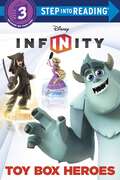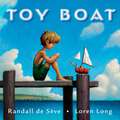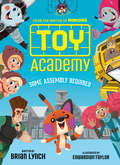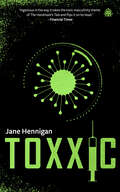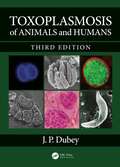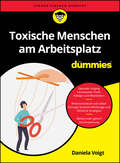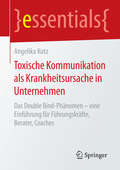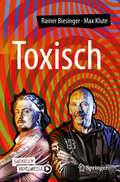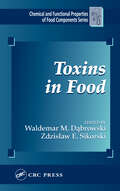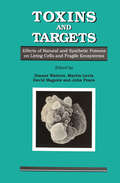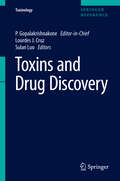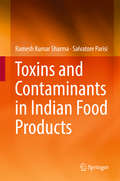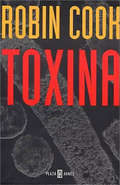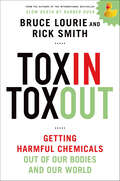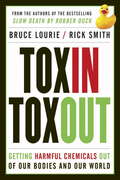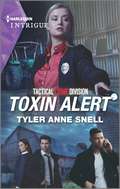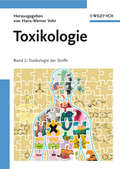- Table View
- List View
Toy Box Heroes (Step into Reading)
by Christy WebsterDisney Infinity is an action-packed video game where players can create their own worlds and play with a mix of characters as wide-ranging as Jack Sparrow from Disney Pirates of the Caribbean to Mike from Disney/Pixar Monsters, Inc., to Anna from Disney Frozen. The world of Disney Infinity is filled with infinite possibilities—and endless fun! Kids will love this Step 3 beginning reader about Jack Sparrow, Rapunzel, and more characters from Disney Infinity!
Toy Boat
by Randall de SèveA little boy has a toy boat. He made it out of a can, a cork, a yellow pencil, and some white cloth. The boy and his boat are inseparable, until one day when the wind pushes the toy boat out into the wide lake. Alone now, the little boat must face fierce waves, a grumpy ferry, a sassy schooner, and a growling speed boat. How the little boat misses the boy! But if he is going to survive, he must figure a way to do it on his own.Loren Long has a timeless and magical touch. As he did with The Little Engine That Could, he creates a world of toys and children that go right to the soul. Toy Boat will sail into young hearts and stay there.Praise for TOY BOAT* "With plenty of buoyant charm and imaginative artwork, this contemporary Little Toot has an abundance of child appeal."--Booklist, starred review"A resonant tale with wide appeal."--Publishers Weekly
Toy Academy: Some Assembly Required (Toy Academy #1)
by Brian LynchA hilarious and heartwarming illustrated novel from the writer of MINIONS; a classic in the making.Playing is serious business.Welcome to Toy Academy: where toys learn to play. This is where action figures train to battle, stuffed animals study the art of the hug, and collectibles practice standing very, very still. Though Grumbolt isn't really any of those things, he's determined to fit in. But when the Evil Toy Academy threatens to bring down his school, it's up to Grumbolt to go where no good toy has gone before and prove he's truly a great toy after all.This laugh-out-loud chapter book by Brian Lynch, the writer of Minions and a writer of The Secret Life of Pets, is a classic in the making.
Toxxic
by Jane HenniganForty years ago, the world changed. Men became crazed killers and threatened all humanity. Now the world might be about to change again, but will it be for the better?Forty-four years ago, as any schoolgirl can tell you, the moth&’s eggs hatched and an army of caterpillars spread their tiny toxic threads on every breath of wind. Since then, men have been cloistered, protected from birth against the deadly poison.But now there&’s a vaccine - a way that men can leave the facility without dying or suffering from psychosis. Emerging, into their new world, eyes wide with wonder at every new experience, the truth soon becomes clear.This world was not made for men. And they are not safe.File Under: Science Fiction [ Threads of Chaos | Long Road Ahead | A Changed Society | What Remains ]
Toxoplasmosis of Animals and Humans
by J. P. DubeyThis is the only book to cover toxoplasmosis of animals and humans thoroughly in one single source. Found worldwide from Alaska to Australasia, Toxoplasma gondii is the cause of one of the most common parasitic infections in humans, livestock, companion animals, and wildlife, and is included on the list of potential bioterrorism microbes. Furthermore, T. gondii has been and continues to be used extensively as a model for the cell biology of apicomplexan parasites. In the decade since the second edition of this book was published, there has been an explosion of knowledge concerning the parasite Toxoplasma gondii and toxoplasmosis. This update provides unique information on all known host types for this parasite, with an additional chapter on history, substantial updates throughout, and a detailed focus on the biology of the parasite in Chapter 2. The third edition is compiled by author JP Dubey, an authority on T. gondii who has worked with virtually all hosts of the protozoan during the last 55 years, including humans, all livestock species, wildlife, and zoo animals. The book distills the voluminous and potentially confusing scientific literature, that has grown geometrically in the 30+ years since the publication of the first edition, into a comprehensive resource for all professionals, graduate students and researchers working in this field.
Toxoplasma gondii: Methods and Protocols (Methods in Molecular Biology #2071)
by Christopher J. TonkinThis volume covers a diverse collection of protocols currently being used by the Toxoplasma research community, and also looks at innovative methods that are pushing the boundaries of possibilities. Chapters in this book discuss topics such as isolation and genotyping of Toxoplasma gondii strains; assessing rhoptry secretion in T. gondii; plate-based quantification of stimulated Toxoplasma egress; methods to study ocular toxoplasmosis; and metabolic analysis of Toxoplasma gondii tachyzoites. Written in the highly successful Methods in Molecular Biology series format, chapters include introductions to their respective topics, lists of the necessary materials and reagents, step-by-step, readily reproducible laboratory protocols, and tips on troubleshooting and avoiding known pitfalls.Cutting-edge and thorough, Toxoplasma gondii: Methods and Protocols is a valuable resource for students or groups starting off in the field, as well as laboratories interested in implementing the latest techniques described in the book.
Toxische Menschen am Arbeitsplatz für Dummies (Für Dummies)
by Daniela VoigtDamit Ihr Traumjob nicht zum Albtraum wird Spinnt Ihr Chef? Nervt Ihr Mitarbeiter? Intrigiert Ihre Kollegin? Manipulatives Verhalten toxischer Menschen in Ihrem Arbeitsumfeld kann Ihr Selbstvertrauen erschüttern und Ihren Traumjob zum Albtraum werden lassen. Lernen Sie die Techniken und Tricks von toxischen Menschen kennen, um sich zu schützen oder aus ihren Fängen zu befreien. Gerade am Arbeitsplatz, wo toxische Dynamiken oft Machtspiele und Manipulation mit sich bringen, sind effektive Strategien essenziell, um emotionale Turbulenzen sicher zu überstehen und Ihre mentale und emotionale Gesundheit zu bewahren. Sie erfahren Wie toxische Menschen am Arbeitsplatz »ticken« Wie Sie manipulative Strategien wie Gaslighting und Hoovering erkennen Welche Abwehrtechniken funktionieren (und welche nicht) Wie Sie sich und Ihre Psyche bei der Arbeit schützen
Toxische Kommunikation als Krankheitsursache in Unternehmen: Das Double Bind-Phänomen – eine Einführung für Führungskräfte, Berater, Coaches (essentials)
by Angelika KutzIn diesem essential untersucht Angelika Kutz die Selbstwert-Vernichtungsmaschinerie des toxischen Kommunikations-Musters ,,Double Bind" als mögliche Ursache der meisten psychisch bzw. psychosomatisch bedingten Ausfälle in Unternehmen sowie hilfreiche Gegenmaßnahmen. Ziel der Autorin ist es, die krankheitsfördernden Kommunikations-Strukturen des Double Binds transparent zu machen. Dies dient der Entlastung von Betroffenen und Führungskräften sowie der Unterstützung für Coaches im Beratungskontext, da krankheitsbedingte Fehlzeiten aufgrund psychischer Erkrankungen heute kontinuierlich zunehmen.
Toxisch
by Rainer Biesinger Max KluteDurch den Konsum von Rauschdrogen ballern sich tagtäglich Millionen von Menschen aus ihrer subjektiv gefühlten Realität heraus. Angefangen bei Alkohol und Nikotin haben wir es heute mit einem verantwortungslosen, unkultivierten und gefährlichen Konsumverhalten zu tun. Dieses Buch stellt die durchaus erlaubte und provokative Frage, ob die derzeitige Drogenpolitik noch „up to date“ ist, bzw. wo sie durch ihre restriktive Herangehensweise nicht völlig versagt hat!? Wo liegen die Ursachen dieses Konsumverhaltens und wie ist es um einen liberalisierten und aufgeklärten Umgang mit gewissen Substanzen bestimmt? Mit diesem mutigen und investigativen Werk nehmen die beiden Autoren eine authentische Perspektive zum Thema Rauschdrogen in Deutschland ein. Und sie wissen, wovon sie reden! Ein Buch für User, Neugierige, Eltern, Pädagogen, Therapeuten, Ärzte, Sozialarbeiter, Interessierte der Drogenverbotsdebatte und alle, denen etwas daran liegt, dass die Gesellschaft in Sachen Suchtprävention und Selbstbestimmungsrecht von Konsumenten endlich wach wird und handelt.Inklusive Videointerviews mit den Autoren und Geleitworte von Kriminalbiologe Dr. Mark Benecke, Jugendrichter Andreas Müller und dem Grimme-Preisträger $ick.
Toxins in Food
by Waldemar M. Dąbrowski Zdzisław E. SikorskiWhile systems such as GMP and HACCP assure a high standard of food quality, foodborne poisonings still pose a serious hazard to the consumer's health. The lack of knowledge among some producers and consumers regarding the risks and benefits related to food makes it imperative to provide updated information in order to improve food safety.To
Toxins and Targets
by David Maguire Dianne Watters John Pearn Martin LavinFirst Published in 1992. The last decade of the twentieth century has seen an unprecedented advocacy for the preservation of a safe environment, and the prevention of ill-health from toxic chemicals. Human activity, however, is responsible for introducing new toxins into the environment. In order to control competitors for human food sources, an armament of pesticides has been assembled and their widespread and largely uncontrolled application has been permitted. It is only when the health of the population begins to suffer from the effects of these chemicals that the efficacy of their use is questioned. Decision-makers whose roles involve the promotion and control of the environment must look to lessons that can be learnt from biosystems that include animals other than man. Toxins and Targets details the way in which organisms from diverse habitats in the plant and animal kingdoms have adapted to handle toxins safely. Part I, on the aquatic environment, highlights the means by which marine organisms have adapted their toxins to be effective in a world of high aqueous solubility and infinite dilution. Part II deals with venomous terrestrial organisms and the mechanisms by which they damage animal cells, and Part III considers the way in which human society attempts to investigate toxicity and to control both synthetic and naturally occurring poisons. The development of a safe environment depends on increased knowledge and novel approaches to solving escalating problems. This book is a step towards this end.
Toxins and Other Harmful Compounds in Foods (Chemical & Functional Properties of Food Components)
by A. Witczak Zdzislaw SikorskiToxins and Other Harmful Compounds in Foods provides information on the contents, distribution, chemical properties, and biological activity of toxins and other harmful compounds in foods that are natural components of the raw materials, accumulated due to microbial actions and environmental pollution, or are generated due to processing. This book shows how different factors related to the production of raw materials, as well as to storage and processing conditions, affect the presence and concentration of toxins and other harmful compounds in foods. It shows how various regulations, as well as unit operations and processes used in food production, may eliminate different toxins or generate new ones. The real health hazards for the consumers resulting from the presence of toxic/harmful compounds in aliments are discussed, and various national and international regulations obligatory in agriculture and industry aimed at increasing food safety are presented. Methods of analysis used for detection and determination of undesirable compounds are also discussed, making it possible to understand the effect of storage and processing parameters, as well as systems of quality assurance, on food safety and to select optimum procedures for analytical control.
Toxins and Hemostasis
by Francis S. Markland Kenneth J Clemetson Mary Ann Mclane R. Manjunatha Kini Takashi MoritaCirculation of blood is vital for the survival of vertebrates, including man. Mainly, it plays an important role in carrying food nutrients and oxygen to every tissue and organ and in removing all waste products and carbon dioxide. Any imbalance in the hemostatic and cardiovascular systems can lead to death and severe debility. A number of animals have developed mechanisms to target these systems and exploit the vulnerability. In some species (for example, snakes), such mechanisms are used to immobilize and kill the victim/prey, whereas in others (for example, insects, such as leaches, mosquitoes and ticks), they are used to provide a continuous supply of blood. These mechanisms include, but are not limited to, procoagulant and anticoagulant actions that affect the coagulation cascade and platelet aggregation, as well as altering vasodilatory responses. In all these various animals, these mechanisms have evolved to perfection over millions of years to support their survival. In last 3-4 decades, due to the efforts of scientists from various backgrounds including biology, protein chemistry, molecular biology, pharmacology, hematology, and structural biology, significant progress in understanding the structure-function relationships, as well as the mechanism of action have been made in a number of exogenous factors that affect blood coagulation, platelet aggregation and vasodilation from various animals. These exogenous factors have contributed significantly to the development of research tools as well as providing new therapeutic agents. With the increase average age of the population coupled with changes in life style in recent years, there has been a significant increase in cardiovascular and hematological disorders. Thus scientists in both academic institutions as well as the pharmaceutical industry are developing better therapeutic agents to improve the quality of life. This impetus has lead to the search for novel agents from various sources that interfere with cardiovascular and hematalogical processes. Although at first glance exogenous factors appear to function as 'villains', several life-saving drugs have been developed based upon these factors. Such drugs or drug leads include those that inhibit the angiotensin converting enzymes (Captopril and Enalapril), that block platelet receptors (Eptifibatide and Tirofiban), or that digest thrombotic plugs (Alfimeprase and bat plasminogen activator) to name a few. Several new and exciting success stories are currently unfolding. In this book, recent studies on some of the exogenous factors that play crucial roles in cardiovascular and hematological disorders are reviewed in order to consolidate the efforts in this area of research and to recruit new, talented researchers. The 25-30 review chapters, each written by experts in their field, compiled herein are devoted to exogenous factors affecting platelet aggregation, anticoagulant and procoagulant proteins, fibrinolytic proteins and hypotensive agents (For details see, Contents of the Book). This book is intended to help to create elevated awareness and enthusiasm in the field of exogenous factors. I believe that this book will provide greater impetus to the search for novel proteins based on naturally occurring exogenous factors. This will be the first book dealing extensively with exogenous factors in the last 25 years. The book will provide a ready reference to the different approaches used to solve complex problems in protein chemistry and pharmacology of exogenous factors. The book will update our understanding of the structure-function relationships and mechanisms of action of exogenous factors and provide great insights into future directions for solving the remaining challenges.
Toxins and Drug Discovery
by Lourdes J. Cruz Sulan LuoThis volume deals mainly with the specialized aspect of toxins and drug discovery. Man has been using natural resources especially plants to treat diseases from very early times in history of mankind. Although many drugs derived from plants and microbes have been discovered and being used in clinical practice, not many drugs have been developed from venoms and toxins although many laboratories worldwide are actively working on it. This volume describe some of the recent developments in this research area, such as snake venoms, conotoxins , bioinformatics in drug discovery from peptide toxins.
Toxins and Contaminants in Indian Food Products
by Salvatore Parisi Ramesh Kumar SharmaThis book discusses the complex of problems of contaminants in foods with the example of Indian food products. The presence and analytical detection of detrimental substances such as pesticides, mycotoxins and other biologically-produced toxins, food chemicals and additives with natural or industrial origin are treated. Furthermore, the book addresses the production and the commercial exploitation of native botanical ingredients, and the question if such ingredients should be regarded as foods or drugs. In the modern highly industrialized world, the interest in organic food production raises. The book sheds light on chemical aspects of organic farming practices in India. Readers will also find information on pesticides and other detrimental chemicals detection in Indian farming. In an outlook, the author reviews the resulting problems, such as how and why this can lead to border rejections during export, in particular to the European Union.
Toxina (Jet Ser. #Vol. 183)
by Robin CookEl maestro del thriller médico, Robin Cook, nos ofrece una espeluznante novela sobre las intoxicaciones alimenticias y la deshumanización de las grandes corporaciones. Kim Reggis, un famoso cirujano cardiovascular, lleva a su hija Becky a cenar la típica hamburguesa con patatas fritas, sin imaginar que este acto cotidiano cambiará su vida para siempre. En los días siguientes, Becky caerá gravemente enferma a causa de una intoxicación producida por una bacteria letal. Desesperado ante el inexorable destino de su hija y poniendo en riesgo su propia vida, Kim decide investigar las causas de la extraña enfermedad, lo que le conducirá por un laberinto de intereses que anteponen los beneficios económicos al juramento hipocrático, y que salpican hasta las más altas instancias gubernamentales.
Toxina
by Robin CookEl maestro del thriller de ambientación médica nos ofrece una espeluznante novela sobre las intoxicaciones alimenticias y la deshumanización de las grandes corporaciones. Kim Reggis, un famoso cirujano cardiovascular, lleva a su hija Becky a cenar la típica hamburguesa con patatas fritas, sin imaginar que este acto cotidiano cambiará su vida para siempre. En los días siguientes, Becky enfermará gravemente a causa de una intoxicación producida por una bacteria letal. A partir de entonces, Kim sufrirá las perturbadoras consecuencias de la realidad médica desde el punto de vista de los pacientes y deberá enfrentarse a las normas y prácticas que anteponenlos beneficios económicos al juramento hipocrático. Desesperado ante el destino inexorable de su hija y a riesgo de su propia vida,Kim decide investigar las causas de la enfermedad, lo que le conducirá por un laberinto de intereses espurios que salpican hasta las más altas instancias gubernamentales.Narrada en un vibrante crescendo de intriga y tensión, Toxina aborda un tema inquietante del que nadie está a salvo: ¿Qué comemos en realidad cuando salimos de casa? ¿Quién controla la calidad de los alimentos consumidos diariamente por millones de personas? ¿Qué intereses sinuosos se mueven tras una inocente hamburguesa o cualquier plato de comida rápida?
Toxin and Bioregulator Weapons: Preventing the Misuse of the Chemical and Life Sciences (Global Issues)
by Michael Crowley Malcolm R. DandoThis book explores how revolutionary developments and convergence of the chemical, life and associated sciences are impacting contemporary toxin and bioregulator research, and examines the risks of such research being misused for malign purposes. Investigating illustrative cases of dual use research of potential concern in China, India, Iran, Russia, Syria and the USA, the authors discuss how states can ensure such research and related activities are not utilised in weapons development. Although toxins and bioregulators are, in theory, covered by both the Biological and Toxin Weapons Convention and Chemical Weapons Convention, this apparent overlap in reality masks a dangerous regulatory gap – with neither Convention implemented effectively to address threats of weaponisation. This book highlights the potentially damaging consequences for international peace and security, and proposes realistic routes for action by states and the scientific community.
Toxin Toxout: Getting Harmful Chemicals Out of Our Bodies and Our World
by Rick Smith Bruce LourieHow do I get this stuff out of me?Bruce Lourie and Rick Smith, two of North America's environmental leaders, have been asked this question on an almost daily basis since the publication of their runaway international bestseller, Slow Death by Rubber Duck: How the Toxic Chemistry of Everyday Life Affects our Health. Their answer? It's not as simple as we'd like, and it's not as easy as we'd hope. But it's too important to ignore. In Toxin Toxout, Lourie and Smith give practical and often surprising advice for removing toxic chemicals from our bodies and homes. There are over 80,000 synthetic chemicals in commerce today, and the authors use their outrageous experiments (they and their brave volunteers are the guinea pigs) to prove how easily our bodies absorb these chemicals. With trademark humor, they give us the good news about what is in our control, the steps we can take to help our bodies remove our toxic burden -- and what we can do to avoid it in the first place. Furthermore, Lourie and Smith investigate the truth behind organic foods, which detox methods actually work, if indoor air quality is improving, how we dispose of waste (where do those chemicals go?), and the ins and outs of a greener economy. The result is nothing short of a prescription for a healthier life.
Toxin Toxout
by Rick Smith Bruce LourieThe Rubber Duck boys are back, and after showing us all the ways that toxins get IN our bodies, now they give us a guide for scrubbing those toxins OUT. Following the runaway success of their first book, 2 of Canada's leading environmental activists give practical and often surprising advice for removing toxic chemicals from our bodies and homes. There are over 80,000 synthetic chemicals in commerce today, including hormone-disrupting phthalates and parabens, cancer-causing pesticides, heavy metals and air pollutants. Rick Smith and Bruce Lourie use their outrageous experiments (they and their brave volunteers are the guinea pigs) to prove how easily our bodies absorb these chemicals from the foods we eat, the air we breathe, and the products we smear on our skin--day after day. Then they give us the good news about what is in our control and the steps we can take for reducing our toxic burden. They investigate the truth behind organic foods, which detox methods actually work, if indoor air quality is improving, and how we dispose of waste (where do those chemicals go?). The result is nothing short of a prescription for a healthier life.
Toxin Alert (Tactical Crime Division: Traverse City #2)
by Tyler Anne SnellAfter biological terrorism rips through an Amish community,the Tactical Crime Division is called in to find out why.Following a deadly anthrax attack, TCD’s biological weapons expert Carly Welsh springs into action. Problem is, the Amish trust no one—especially not an FBI special agent. That’s where Noah Miller comes in. Even though the rancher left the fold decades ago, the community trusts him…and so does Dr. Welsh. But even their combined courage and smarts might not be enough against sinister forces that want them both to perish.From Harlequin Intrigue: Seek thrills. Solve crimes. Justice served.Tactical Crime Division: Traverse CityBook 1: Rookie Instincts by Carol EricsonBook 2: Toxin Alert by Tyler Anne Snell
Toxin (Paperback Bestsellers Ser.)
by Robin CookNewly divorced surgeon Dr. Kim Regis is determined to remain a good father to his only son, Selden. On a special night out, Kim takes Seldon to his favorite fast-food restaurant for a feast of burgers and fries. <P><P>But the good time turns to tragedy: the young boy becomes gravely ill and dies as a result of poisoning by E. coli. bacteria found in the meat. <P> Was Seldon's death a result of shoddy food-handling practices? Or was it a sophisticated case of product tampering - by a rival fast-foot giant or a disgruntled employee? Or perhaps by someone with a score to settle with Kim? Taking a leave from his surgical practice, Kim devotes his energies to solving the mystery full time. But he immediately hits a brick walls: a code of silence more impenetrable than anything he has ever encountered in his medical career. Instead of a cold-shoulder reception, however, Kim is soon met with a boot and a fist as thugs attempt to quash his inquiry. <P> Aided by his ex-wife, Kim pursues a trail of deadly evidence, uncovering complicity and guilt stretching from the slaughterhouse floor to the corporate boardroom. Racing against time before more are poisoned, the two come face-to-face with the shocking and elusive truth. And in their life-and-death search for answers, they rediscover the reasons they first fell in love. <P> With trademark pulse-pounding flair, Robin Cook delivers a cutting-edge thriller, borrowing from today's fears and tomorrow's medical technology.
Toxikologie: Band 2 - Toxikologie der Stoffe
by Hans-Werner Vohr Herausgegeben VonIm zweiten Band dieses modular aufgebauten Lehrbuchs wird die Exposition und toxische Wirkung der wichtigsten toxischen Chemikalien abgehandelt. (Nano-)Partikuläre Stoffe, Metalle, anorganische und organische Verbindungen werden systematisch betrachtet und in ihren chemischen Eigenschaften, Expositionen, Wirkmechanismen und Toxikodynamik beschrieben, ergänzt durch experimentelle Daten von Mensch und Tier. Ein besonderes Highlight ist das Kapitel über chemische Kampfstoffe, das in Zusammenarbeit mit Fachleuten der Bundeswehr entstanden ist. Leseempfehlungen und Fragen zur Selbstkontrolle runden dieses Buch ab. Zusammen mit dem ersten Band ("Grundlagen der Toxikologie") enthält dieses Buch das gesamte Grundlagenwissen für die Ausbildung zum Fachtoxikologen und für den Masterstudiengang Toxikologie. Begleitmaterial für Dozenten verfügbar unter www.wiley-vch.de/textbooks
Toxikologie: Band 1 Grundlagen der Toxikologie
by Hans-Werner Vohr Herausgegeben VonPerfekt abgestimmt auf die moderne Ausbildung zum Toxikologen, werden in diesem Lehr- und Prüfungsbuch alle wichtigen Konzepte und wissenschaftlichen Grundlagen der Toxikologie erklärt: von der molekularen Toxikologie bis hin zu Risk Assessment und Epidemiologie. Besonderes Highlight sind mehrere Kapitel zu den aktuellen Hauptarbeitsfeldern der Toxikologie, u.a. die Kontrolle und Bewertung von Belastungen am Arbeitsplatz und in Gebäuden sowie des Gefahrenpotentials von Nahrungs- und Arzneimitteln. Leseempfehlungen und Fragen zur Selbstkontrolle runden dieses Buch ab. Zusammen mit dem zweiten Band ("Toxikologie der Stoffe") ist das gesamt Grundlagenwissen für die Ausbildung zum Fachtoxikologen und für den Masterstudiengang Toxikologie enthalten. Begleitmaterial für Dozenten verfügbar unter www.wiley-vch.de/textbooks
